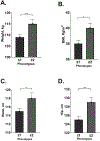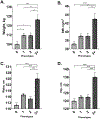Cumulative effect of obesity phenotypes on body weight and body mass index
- PMID: 38418919
- PMCID: PMC11938356
- DOI: 10.1038/s41366-024-01492-9
Cumulative effect of obesity phenotypes on body weight and body mass index
Abstract
Background: Obesity originates from an imbalance between energy intake and expenditure. Changes in energy intake components (satiation, postprandial satiety, emotional eating) and energy expenditure have been linked to obesity and are referred to as obesity phenotypes. We aim to study if these obesity phenotypes have a cumulative effect on body weight and body mass index (BMI).
Subject/methods: This is a cross-sectional study of adult patients with obesity (BMI > 30 kg/m2) who completed the validated tests to measure the obesity phenotypes. A total of 464 were included in this study.
Interventions/methods: We defined higher calories to fullness during an ad libitum meal as abnormal satiation, accelerated time to half gastric emptying with scintigraphy as abnormal postprandial satiety, higher anxiety score on the Hospital Anxiety and Depression Scale as hedonic eating behavior, and decreased percentage of measured resting energy expenditure as abnormal energy expenditure. The primary analysis was done on the number of phenotypes ( ≤ 1 and ≥ 2) with body weight and BMI using an independent t-test.
Results: Our cohort included 464 patients (mean [SD] age 42.0 [10.9] years, 79% females, weight 111.2 [22.9] kg, BMI 38.9 [7.0] kg/m2). There were 294 patients who had ≤ 1 phenotype, and 170 patients with ≥ 2 phenotypes with no baseline demographical differences (i.e., age and sex). Having ≥ 2 phenotypes was associated with higher body weight (115 [25] kg vs. 109 [21] kg; p = 0.004), BMI (40 [8] kg/m2 vs. 38 [7] kg/m2; p = 0.02) and waist (118 [15] cm vs. 115 [13] cm; p = 0.04) and hip (129 [14] cm vs. 125 [13] cm; p = 0.01) circumferences compared to ≤ 1 phenotype.
Conclusion: Obesity phenotypes are associated with an additive effect on the body weight and BMI. Patients who have multiple obesity phenotypes may require a more aggressive approach to enhance weight loss.
© 2024. The Author(s), under exclusive licence to Springer Nature Limited.
Conflict of interest statement
COMPETING INTERESTS
Dr. Acosta is a stockholder in Gila Therapeutics, Phenomix Sciences; he served as a consultant for Rhythm Pharmaceuticals, Nestle, Structure Therapeutics and Amgen Pharmaceuticals. There are no other disclosures. All other authors declare no competing financial interests.
Figures



Similar articles
-
Quantitative gastrointestinal and psychological traits associated with obesity and response to weight-loss therapy.Gastroenterology. 2015 Mar;148(3):537-546.e4. doi: 10.1053/j.gastro.2014.11.020. Epub 2014 Dec 6. Gastroenterology. 2015. PMID: 25486131 Free PMC article. Clinical Trial.
-
Relationship of gastric emptying or accommodation with satiation, satiety, and postprandial symptoms in health.Am J Physiol Gastrointest Liver Physiol. 2017 Nov 1;313(5):G442-G447. doi: 10.1152/ajpgi.00190.2017. Epub 2017 Aug 3. Am J Physiol Gastrointest Liver Physiol. 2017. PMID: 28774870 Free PMC article.
-
Association Between Food Intake and Gastrointestinal Symptoms in Patients With Obesity.Gastro Hep Adv. 2023;2(1):121-128. doi: 10.1016/j.gastha.2022.07.019. Epub 2022 Aug 7. Gastro Hep Adv. 2023. PMID: 36741967 Free PMC article.
-
Dietary fiber and weight regulation.Nutr Rev. 2001 May;59(5):129-39. doi: 10.1111/j.1753-4887.2001.tb07001.x. Nutr Rev. 2001. PMID: 11396693 Review.
-
The role of gastric function in control of food intake (and body weight) in relation to obesity, as well as pharmacological and surgical interventions.Neurogastroenterol Motil. 2024 Feb;36(2):e14660. doi: 10.1111/nmo.14660. Epub 2023 Aug 28. Neurogastroenterol Motil. 2024. PMID: 37638839 Review.
Cited by
-
Novel Therapeutic Approach for Obesity: Seaweeds as an Alternative Medicine with the Latest Conventional Therapy.Med Sci (Basel). 2024 Oct 13;12(4):55. doi: 10.3390/medsci12040055. Med Sci (Basel). 2024. PMID: 39449411 Free PMC article. Review.
-
Multi-modal neo-adjuvant anti-obesity medications may be more effective than medically supervised weight loss or GLP-1 therapy alone in preparing BMI≥70 patients for metabolic surgery.Int J Obes (Lond). 2025 Aug;49(8):1516-1522. doi: 10.1038/s41366-025-01798-2. Epub 2025 Jun 2. Int J Obes (Lond). 2025. PMID: 40456879 Free PMC article.
-
Precision Medicine for Obesity Treatment.J Endocr Soc. 2025 Jun 5;9(9):bvaf102. doi: 10.1210/jendso/bvaf102. eCollection 2025 Sep. J Endocr Soc. 2025. PMID: 40636093 Free PMC article. Review.
References
-
- Conway B, Rene A. Obesity as a disease: no lightweight matter. Obes Rev. 2004;5:145–51. - PubMed
-
- Lobstein TBH, Neveux M. World obesity atlas 2022. In, 2022. https://www.worldobesity.org/resources/resource-library/world-obesity-at....
-
- Gala K, Ghusn W, Fansa S, Abu Dayyeh BK, Ghanem OM, Kellogg T, et al. Effects of heterozygous variants in the leptin-melanocortin pathway on transoral outlet reduction after roux-en-y gastric bypass: a case-control study and review of literature. Obes Surg. 2023;33:1284–8. - PubMed
-
- Apovian CM. Obesity: definition, comorbidities, causes, and burden. Am J Manag Care. 2016;22:s176–85. - PubMed
-
- Hagan S, Niswender KD. Neuroendocrine regulation of food intake. Pediatr Blood Cancer. 2012;58:149–53. - PubMed
Publication types
MeSH terms
Grants and funding
LinkOut - more resources
Full Text Sources
Medical

